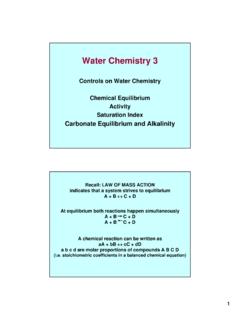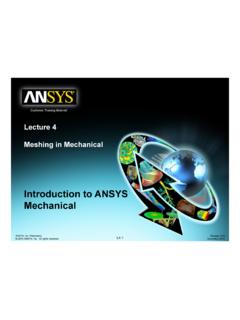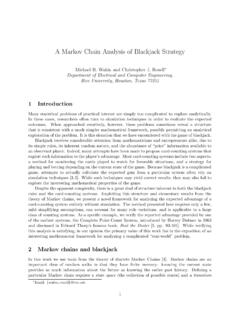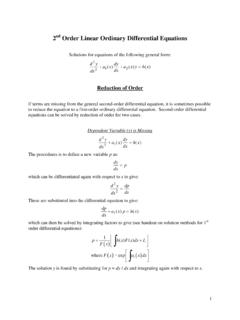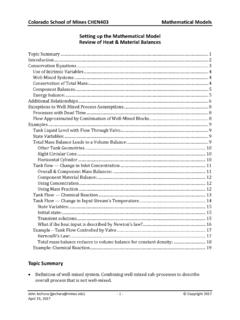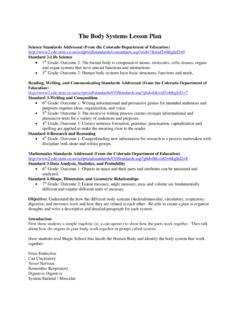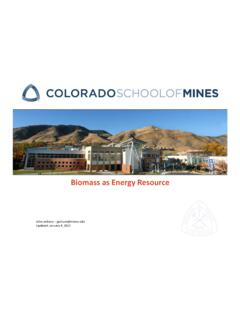Transcription of Oscillating Chemical Reactions - Inside Mines
1 Oscillating Chemical Reactions [modified from an article by Earle S. Scott, Rodney Schreiner, Lee R. Sharpe, Bassam , and Glen E. Dirreen]IntroductionOscillating Reactions are among the most fascinating of Chemical Reactions . In one type of reaction,a mixture of chemicals goes through a sequence of color changes, and this sequence repeatsperiodically. In another, the mixture periodically emits a burst of gas, foaming up. To many, Oscillating Reactions are engaging examples of " Chemical magic." To those having someacquaintance with chemistry, these Reactions are a mystery and a challenge. To everyone, they arememorable demonstrations of the wonder of what makes Oscillating Reactions so fascinating to chemists is that they seem to contradictcommon sense. Experience tells us that, under a given set of conditions, Chemical Reactions go inonly one direction. We rarely find a Chemical reaction that appears to reverse itself, much less to doso repeatedly.
2 When we do encounter such a reaction, we may be inclined to draw an analogy to asimple physical oscillator such as a pendulum. A pendulum oscillates from side to side through itsequilibrium position, and these oscillations can be attributed to the interconversion between thepotential and kinetic energy of the pendulum. Analogous to this physical process, the chemicaloscillator may seem to swing through its equilibrium composition. However, this is contrary to thesecond law of thermodynamics, which asserts that once a Chemical system reaches equilibrium, itcannot deviate from that condition spontaneously. Therefore, oscillations in Chemical reactionscannot be like the oscillations of a pendulum; Chemical Reactions cannot oscillate through theequilibrium more appropriate physical model for an Oscillating Chemical reaction would be a grandfather'sclock. The hands of the clock pass repeatedly (twice daily) through the same position, but theenergy stored in the elevation of the weights decreases continuously as the clock runs.
3 In anoscillating Chemical reaction, the concentrations of some components of the reaction mixture passrepeatedly through the same value, but the energy-releasing reaction that drives the oscillationsproceeds continuously toward completion. Just as the clock is running down while its hands rotate,the Chemical oscillator is running down toward equilibrium as it oscillates. In order to exhibitoscillations, a Chemical system must be far from its equilibrium oscillations in an Oscillating Chemical reaction are driven by the decrease in free energy of themixture. This decrease is what drives all Chemical Reactions , but not all Chemical Reactions exhibitoscillations. There must be some feature peculiar to Oscillating Reactions that allows them todisplay this unusual behavior. This feature occurs in the pathways these Reactions take as theyapproach equilibrium, in other words, in their reaction mechanisms. The pathway that a reactionfollows determines how the concentrations of its components change as the reaction proceeds.
4 Themore complex the pathway of the reaction is, the more complex the changes in concentration of thecomponents can Lab 3 / do Reactions oscillate?The problem of how Oscillating Chemical Reactions occur has been examined theoretically toestablish ways in which oscillations can happen. The reaction mechanisms of all known chemicaloscillators have at least three common features. First, while the oscillations occur, the chemicalmixture is far from equilibrium, and an energy releasing reaction occurs whose energy drives theoscillating "sideshow." Second, the energy-releasing reaction can follow at least two differentpathways, and the reaction periodically switches from one pathway to another. Third, one of thesepathways produces a certain intermediate, while another pathway consumes it, and theconcentration of this intermediate functions as a "trigger" for the switching from one pathway tothe other. When the concentration of the intermediate is low, the reaction follows the producingpathway, leading to a relatively high concentration of the intermediate.
5 When the intermediate'sconcentration is high, the reaction switches to the consuming pathway, and the concentration of theintermediate decreases. Eventually the reaction reverts to the producing pathway. The reactionrepeatedly switches from one pathway to the will explore these general ingredients of an Oscillating reaction using the CKS software later,after performing the experiments on a particularly visually striking Oscillating reaction, the Briggs-Rauscher Lab 3 / ReactionAbstractThree colorless solutions are combined in a large beaker and stirred on a magnetic stirrer. Thesolution becomes amber, then blue-black, and then colorless again. This sequence of color changesrepeats with a period of approximately 15 seconds at 25 C. The period of the oscillation graduallyincreases, and after several minutes, the blue-black color persists. The electrical potential of thesolution oscillates along with its color, and the range of these oscillations is about 60 Briggs-Rauscher reaction was developed by Thomas S.
6 Briggs and Warren C. Rauscher ofGalileo High School in San Francisco [1]. It is perhaps the most visually impressive of thechemical oscillators. A stirred batch of solution goes through 15 or more cycles of colorless, toamber, to blue-black, before ending as a blue-black mixture with the odor of Briggs-Rauscher (BR) reaction is a hybrid of two other Oscillating Chemical Reactions , theBray-Liebhafsky (BL) reaction and the Belousov-Zhabotinsky (BZ) reaction. Bray wasinvestigating the dual role of H2O2 as an oxidizing agent and a reducing agent when he discoveredoscillations in the evolution of oxygen gas from the reaction mixture [2]. He mixed H2O2, KIO3,and H2SO4, and in this mixture, hydrogen peroxide reduced iodate to iodine and was oxidized tooxygen gas in the H2O2 (aq) + 2 IO3- (aq) + 2 H+(aq) -> I2 (aq) + 5 O2(g) + 6 H2O (l)(1)The hydrogen peroxide also oxidizes iodine to H2O2 (aq) + I2 (aq) -> 2 IO3- (aq) + 2 H+(aq) + 4 H2O (l)(2)The net result of these Reactions is the iodate catalysis of the disproportionation of H2O2 (aq) -> O2 (g) + 2 H2O (l)(3)The discovery of oscillations prompted Liebhafsky to study this reaction before 1933 and after1969 [3], when he retired from a career as an industrial chemist, but few others paid much attentionto this reaction until after the discovery of the BZ reaction.
7 Belousov reported oscillations duringthe reaction of citric acid with acidic bromate ions and cerium(IV) ions [4]. This oscillatorybehavior was exploited by Zhabotinsky, who discovered that oscillations still occurred if certainother organic compounds, such as malonic acid , were substituted for citric acid , and if other one-electron transfer agents, such as Mn(II) ions, were substituted for cerium ions [5-7].Briggs and Rauscher combined the hydrogen peroxide and iodate of the BL reaction with themalonic acid and manganese ions of the BZ reaction, and discovered the Oscillating reaction thatbears their name. In the BR Oscillating reaction, the evolution of oxygen and carbon dioxide gasesWet Lab 3 / the concentrations of iodine and iodide ions oscillate. These oscillations are represented in thefigure. Iodine is produced rapidly when the concentration of iodide ions is low. As theconcentration of iodine in the solution increases, the amber color of the solution intensifies.
8 Theproduction of I- increases as [I2] increases, and these ions react with iodine molecules and starch toform a blue-black complex containing the pentaiodide ion (I5-) [9]. Most of the O2 and CO2 isproduced during the formation of I2. The [I2] reaches a maximum and begins to fall, although [I-]rises further and remains high as [I2] continues to decline until the solution clears. Then the [I-]suddenly falls and the cycle begins again. This cycle repeats a number of times until the solutionends as a deep blue mixture that liberates iodine Variations with time of O2, I3-, iodomalonic acid , and I2 concentrations (inmoles per liter), of pI-, of gas evolution (in arbitrary units), and of temperature (inCelsius) during one oscillation of a BR reaction (Source: Figure 4 [8]).The mechanism of this reaction has been studied by Cooke [10-12], by Furrow and Noyes [13-15],and by De Kepper and Epstein [16]. The results of their investigations led them to similarconclusions about the nature of the mechanism.
9 Much of the proposed mechanism is a directtransfer of the mechanism of the BZ reaction to the iodate-hydrogen peroxide system. Theproposed mechanism is only a skeleton of what happens during the reaction. It does not account forthe production of CO2, nor does it identify the ultimate organic products of the reaction; theseWet Lab 3 / are still under investigation. However, it does explain the origin of the oscillations in theconcentrations of I2 and transformation that accounts for the oscillations in the BR reaction is represented in equation + 2 H2O2 + CH2(CO2H)2 + H+ -> ICH(CO2H)2 + 2 O2 + 3 H2O(4)This transformation is accomplished through two component Reactions (equations 5 and 6).IO3- + 2 H2O2 + H+ -> HOI + 2 O2 + 2 H2O(5)HOI + CH2(CO2H)2 -> ICH(CO2H)2 + H2O(6)The first of these two Reactions can occur via two different processes, a radical process and anonradical process. Which of these two processes dominates is determined by the concentration ofiodide ions in the solution.
10 When [I-] is low, the radical process dominates; when [I-] is high, thenonradical process is the dominant one. The second reaction (equation 6) couples the twoprocesses. This reaction consumes HOI more slowly than that species is produced by the radicalprocess when that process is dominant, but it consumes HOI more rapidly than it is produced by thenonradical process. Any HOI which does not react by equation 6 is reduced to I- by hydrogenperoxide as one of the component steps of the nonradical process for reaction 5. When HOI isproduced rapidly by the radical process, the excess forms the iodide ions, which shut off thatradical process and start the slower nonradical process. Equation 6 then consumes the HOI sorapidly that not enough is available to produce the iodide ion necessary to keep the nonradicalprocess going, and the radical process starts again. Each of the processes of equation 5 producesconditions favorable to the other process, and, therefore, the reaction oscillates between these mechanism will be discussed in more detail Lab 3 / liters distilled water410 mL 30% hydrogen peroxide, H2O243 g potassium iodate, mL concentrated (18M) sulfuric acid , H2SO416 g malonic acid , CH2(CO2H) g manganese(II) sulfate monohydrate, MnSO4 g soluble starch20 g sodium thiosulfate, Na2S2O3 (See Disposal section for use.)
